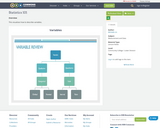
This visualizes how to describe variables.
- Subject:
- Measurement and Data
- Material Type:
- Lecture Notes
- Author:
- Michelle Lin
- Date Added:
- 06/23/2020

This visualizes how to describe variables.

In this lesson students will identify the three major sections of the United States Constitution and explain the purpose of each of those three sections.
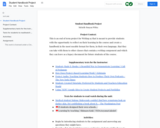
This is an end of term project for Writing 95 that is meant to provide students with the opportunity to reflect on their learning in the course and create a handbook in the most useable format for them, in their own language, that they can take with them to other classes that contain a writing component and which they can leave as a legacy document for future students of the course.
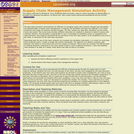
A free online simulation that demonstrated the bull-whip effect, and the complexities of supply chain management, responding to changes in customer demand.
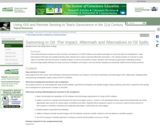
This activity introduces students to basic functions and features of ArcGIS software and explores principles of a GIS and data set manipulations, using observational GPS data and satellite telemetry data collected from marine mammals fitted with transmitters. This activity provides an overview of using maps as scientific tools and the power of spatial analysis in science and problem solving. Students move through progressively challenging activities that encourage spatial thinking and using a process of feedback and inquiry to ask and answer spatially and temporally related environmental questions.
(Note: this resource was added to OER Commons as part of a batch upload of over 2,200 records. If you notice an issue with the quality of the metadata, please let us know by using the 'report' button and we will flag it for consideration.)

Interval training is a great way to keep your class fast paced, students engaged and they are easy to apply to future assessment tools. Incorporate fun music and your students will be asking to do tabata's once a week. (We call it Tabata Tuesday in my classes)

Add the General description for teachers to see. And resource added in the "Add Resource" will be for the teacher only.

In this activity, students will create a segment of DNA out of wire and play-doh. Using a simple computer code, they will make their DNA talk by connecting a Makey Makey circuit board and hooking it up to a computer.
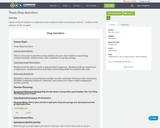
A great activity for students to collaborate and be creative all while incorporating movement. Students will be asking to do this one again!
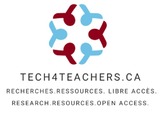
Research, resources, and real talk about tech for the next generation of educational leaders. A collection of open-access resources for pre-service teacher candidates in Ontario who are interested in developing skills and methods for the evidence-informed use of digital technologies in classrooms. Includes resources about assistive technologies and accessibility, tech tip sheets, evidence-informed practice posters about various technologies (ex. Padlet), and suggested activities. Available in English and in French.
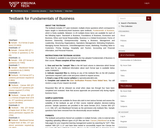
The testbank includes 377 peer-reviewed, multiple-choice questions which correspond to topics taught in introductory-level business open textbook, "Fundamentals of Business." "Fundamentals of Business" is a freely available, openly licensed resource available at: http://hdl.handle.net/10919/84848 .
Between 11-29 multiple-choice items are available for each of the following topics: Teamwork in Business, Foundations of Business, Economics and Business, Ethics and Social Responsibility, Business in a Global Environment, Forms of Business Ownership, Entrepreneurship: Starting a Business, Management and Leadership, Structuring Organizations, Operations Management, Motivating Employees, Managing Human Resources, Union/Management Issues, Marketing: Providing Value to Customers, Pricing Strategy, Hospitality and Tourism, Accounting and Financial Information, and Personal Finances.
The testbank is available to any instructor who has adopted Fundamentals of Business in their course. Please complete the four steps listed at http://hdl.handle.net/10919/93404 to request access to the testbank.
1. View and test the "sample" files at http://hdl.handle.net/10919/93404 in the left hand column to determine which format works best for you. Additional information about each format type is available below under FORMATS.
2. Indicate requested files by clicking on any of the testbank files at http://hdl.handle.net/10919/93404 on the left (marked "permission required") add a note and press submit to request access.
3. Email a copy of the course syllabus to openeducation@vt.edu
4. Complete and submit the User Verification Process Form https://forms.gle/ueaihc96LgNrE9uf9. You will receive a copy of your request via email.
Requested files will be released via email when steps two through four have been completed and reviewed. Note that access approvals are processed only during regular business hours.
Please visit: http://hdl.handle.net/10919/93404 for Terms of Use, license information, and to view or report errata.
SAMPLE QUESTIONS
Sample questions are available for those who wish to test various formats and assess the suitability of the testbank as part of their course material adoption decision-making process. Sample questions are provided in the same formats (XLS, Canvas IMS QTI 1.1.3, XML QTI, and Blackboard formats) as the permission-only testbank files. Sample questions have been removed from the electronically secure testbank.
FORMATS
The testbank and portions thereof are available in multiple formats. Links to external sites regarding uploading different types of QTI files are here: Canvas | Blackboard or on the help pages for your respective learning management system by searching for "QTI". Files marked "IMS QTI 1.1.3" and have been tested to successfully import into Canvas but may work with other LMS/VLE systems. Please use the sample files to determine if one of the export formats will work for your specific situation. Please note that we are unable to provide additional file types, support for uploading, or assistance with reformatting files. Please contact your local learning management system (LMS) manager for additional support.
Distribution
The information in the testbank is of a proprietary nature, produced by or for faculty of public institutions of higher education as a result of collaborative study, research, and peer review. Because it is intended to be used in student assessment the information has not been publicly released or published.
If you become aware of public distribution of the testbank or portions thereof shared outside of a secure electronic environment, assessment context, or other security breach please inform us at: openeducation@vt.edu
LIABILITY
The testbank and testbank items are provided "as is." Users of this resource assume all risks and further agree to hold Virginia Tech, the Commonwealth of Virginia and their employees and agents, and project contributors harmless from any and all actions related to use of this program.
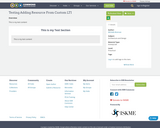
This is my test content
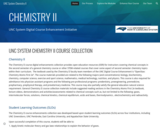
The Chemistry II course digital enhancements collection provides open education resources (OER) for instructors covering chemical concepts in the second semester of a general chemistry course or other STEM-related courses that cover some aspect of second semester chemistry topics within their curriculum. The textbook used by the Chemistry II faculty team members of the UNC Digital Course Enhancement is “OpenStax: Chemistry Atoms First 2e”. The course materials provided are related to the following majors (and concentrations): biology, biochemistry, chemistry, computer science, exercise and sport science, mathematics, medical technology, nutrition, and physics. This course is also required for admittance into physician assistant programs and the following pre-professional programs: predentistry, preengineering, premedicine, prepharmacy, prephysical therapy, and preveterinary medicine. This course may also partially satisfy the general education natural science requirement.
General Chemistry II course collection materials include suggested reading sections in the Chemistry Atoms First 2e textbook, lecture videos, demonstrations and activities/assessments related to chemical concepts such as, but not limited to the following: gases, intermolecular forces, solutions, chemical kinetics, chemical equilibrium, acids and bases, thermodynamics , electrochemistry and radioactivity.
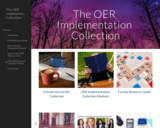
The OER Implementation Collection is a companion to the UNC digital course enhancement collections. It was developed for faculty, instructors, and librarians in the UNC System by open educational resources (OER) experts from NC State University, East Carolina University, UNC Greensboro, UNC Charlotte, North Carolina A&T, University of North Carolina School of the Arts, and UNC Chapel Hill.
The collection gathers reliable open resources and provides videos of presentations from authoritative speakers to answer the most frequent questions faculty ask about how and why to use OER in their courses. The OER Implementation Collection will provide a guide to finding and using OER for faculty and instructors who are interested in working with the UNC digital course enhancement collections and using other open educational resources in their teaching.
After using this collection, participants will:
Understand what OER are
Describe how OER benefit students and faculty
Find OER that are relevant for their courses
Determine quality and value of OER that they find
Adapt existing OER to fit their courses
Learn how to create their own OER
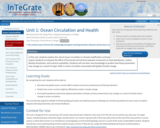
In this unit, students explore the role of ocean circulation in climate modification and bioproductivity. The activities require students to interpret the effect of horizontal and vertical seawater movement on heat distribution, carbon dioxide dissolution, and nutrient availability. Students will use their new knowledge to predict how those parameters may change as a result of major shifts in ocean circulation associated with global climate change.
(Note: this resource was added to OER Commons as part of a batch upload of over 2,200 records. If you notice an issue with the quality of the metadata, please let us know by using the 'report' button and we will flag it for consideration.)
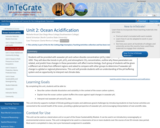
Students will be provided with seawater pH and carbon dioxide concentration (pCO2) data spanning as far back as 1850. They will describe trends in pH, pCO2 and atmospheric CO2 concentration, outline why these parameters are related, and predict how changes in these parameters will affect marine biology. Each group of students will be given a different set of data from different regions and asked to compare with other groups to determine if seawater pH change is a global or regional phenomena. This unit will provide students with an understanding of the pH buffering system and an opportunity to interpret real climate data.
(Note: this resource was added to OER Commons as part of a batch upload of over 2,200 records. If you notice an issue with the quality of the metadata, please let us know by using the 'report' button and we will flag it for consideration.)
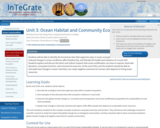
Students will be able to identify the functional roles that organisms play in ocean ecosystems. How do human-induced changes in ocean conditions affect biodiversity, and thereby the health and resilience of a coral reef? Students explore and discuss the direct and indirect impacts that ocean acidification can have on species, food web dynamics, ecosystem function, and commercial resources. At the end of this unit the students should be able to articulate how changes in ocean chemistry can create negative outcomes for humans who depend on living ocean resources.
(Note: this resource was added to OER Commons as part of a batch upload of over 2,200 records. If you notice an issue with the quality of the metadata, please let us know by using the 'report' button and we will flag it for consideration.)
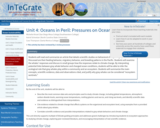
Students will read and summarize an article that details scientific studies on behavioral changes of gray whales. Discussed are their feeding behavior, migratory behavior, and breeding patterns in the Pacific. Students will examine the whales' responses and discuss in small groups how the responses relate to climate change. By interpreting potential links between gray whale behavior and changed ocean conditions, students will be able to infer the ecological role that gray whales play within a community and an ecosystem. Students will summarize the main concepts, scientific evidence, data and observations cited, and justify why gray whales can be considered "ecosystem sentinels."
(Note: this resource was added to OER Commons as part of a batch upload of over 2,200 records. If you notice an issue with the quality of the metadata, please let us know by using the 'report' button and we will flag it for consideration.)
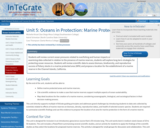
Students will review current ocean pressures related to overfishing and human impacts on ocean ecosystems. By examining data collected in relation to the presence of marine reserves, students will explore long-term strategies for protecting ocean resources. Students will review scientific data to assess biomass, biodiversity, and reproductive success of fishery stocks in a marine protected area (MPA) and propose a location for the establishment of a marine reserve in the Channel Islands, California.
(Note: this resource was added to OER Commons as part of a batch upload of over 2,200 records. If you notice an issue with the quality of the metadata, please let us know by using the 'report' button and we will flag it for consideration.)
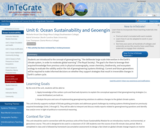
Students are introduced to the concept of geoengineering, "the deliberate large-scale intervention in the Earth's climate system, in order to moderate global warming" (The Royal Society). The goal is for them to leverage their acquired knowledge from previous units in physical oceanography, ocean chemistry, biodiversity, and ecosystem ecology to evaluate the validity and/or the risk of geoengineering (systems thinking). Current and future generations will be required to make informed decisions on whether they support strategies that result in irreversible changes in Earth's carbon cycle.
(Note: this resource was added to OER Commons as part of a batch upload of over 2,200 records. If you notice an issue with the quality of the metadata, please let us know by using the 'report' button and we will flag it for consideration.)